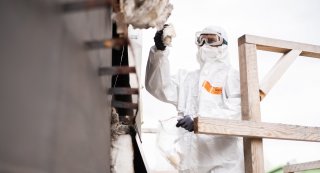Investigations of pollutants and impurities

Our services
- General pollutant and contaminant assessment in compliance with Austrian standard ÖNORM B3151
- For > 750 t construction/demolition waste and < 3500m³ enclosed space
- Comprehensive pollutant and impurities assessment in compliance with ÖNORM EN ISO 16000-32
- For > 750 t construction/demolition waste and > 3500m³ enclosed space
- Pollutants and impurities assessment and documentation
- Preparation of a demolition strategy
- Provision of a demolition expert and supervision of waste management during demolition
- Elimination of pollutants and impurities
- Confirmation of elimination by means of a release log before mechanical demolition
- Preparation of a disposal strategy
- Demolition and recycling of rubble to ensure a fully closed-loop economy
Your benefits
- Prerequisite for efficient clean-up
- Legal certainty
- Safeguards property value
- Climate protection through increased recycling rates
- Decades of experience and qualified specialist personnel
- Independent, accredited chemical laboratory
- Efficient, environmentally-friendly recycling
You want to use our service?
We are looking forward to your enquiry!
Frequently asked questions
A pollutant and contaminant assessment is mandatory for waste quantities of 750 tonnes or more. This does not apply to renovations and conversions of smaller buildings, such as detached houses. A pollutant and contaminant assessment is not obligatory in these circumstances, but it is recommended.
Demolition materials from private households’ smaller construction projects can usually be left free of charge at recycling centres or waste material collection centres run by local authorities or waste management associations. However, hazardous building materials such as asbestos cement (Eternit panels) must also be collected separately here.
Hazardous waste (contaminants), e.g. asbestos, materials containing tar, insulation boards containing (H)CFCs (XPS, EPS), must be separated from non-hazardous waste (impurities) and from the materials intended for recycling. The context here is that contaminants prevent recycling. Impurities also have a strong negative impact on the quality of recycled building materials. Excavated soil and asphalt, wood, metal, plastic and municipal waste must also be separated from each other and from mineral waste (concrete, bricks, rubble). If you have any questions, our customer service team will be happy to help.